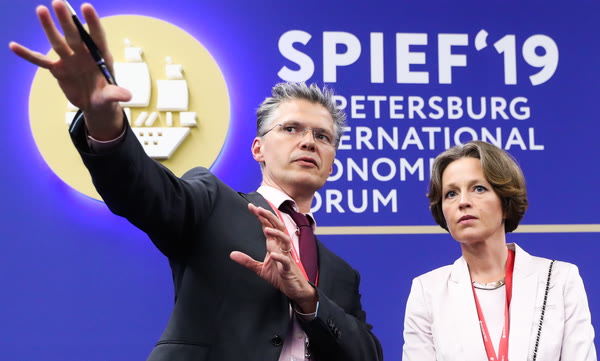
The Search for Middle Class Stability in a Changing World
KEY CONCLUSIONS
In emerging economies the middle class is growing
“In 1991, 30 to 40 million people belonged to the middle class. Now that number is 500 million. All thanks to what we've done. This is not a just a figure, it is the result of the concrete actions that we took,” Siddharth Bhatia, Vice President, National Investment Promotion and Facilitation Agency of India.
The educated middle class is the driving force of economic development
“The economy is oriented towards attracting and making investments, towards creating an environment that facilitates business development, not just on a national level, but when entering global markets. <...> Also, young people, the youth, the development of professional competencies, and accordingly the preparation of new professionals in competitive sectors. <...> We are doing a lot in this sense, especially when it comes to investing in R&D,” Joao Jorge Arede Correia Neves, Secretary of State of Economy of the Portuguese Republic.
“The middle class has high social stability. It is the part of the population that creates demand for modernization and transformation,” Ekaterina Trofimova, Partner, Deloitte CIS.
In developed countries, the middle class has a significant impact on politics
“Around 2023 to 2033, we will be able to discern the political result of the 2008 crisis. <...> Large stock market crashes cause concern among the middle class. We have seen this happen twice already in the last century. Right now, it is not yet clear if we are seeing a drift towards right-wing populism, towards anti-immigration, protectionist rhetoric, or a shift to the left – increasing taxes for the rich, increasing taxes on capital, breaking apart Google, Facebook, and any other large corporate monopolies,” Charles Robertson, Global Chief Economist, Renaissance Capital.
“We, in fact, as a bank think that inequality will be one of the key driving forces of macroeconomic policy and therefore also ultimately shape financial markets over the next couple of decades. Simply because, we are definitely seeing that populations are not happy with the status quo. <…> Which basically means that going forward you're going to have to look at financial markets more from the perspective of more expansionary fiscal policy, higher taxes, more tariffs, less so through the lens of monetary policy – QE – that has really dominated over the course of the last 10 years,” David Hauner, Head of Emerging Markets Economics & Strategy, EMEA, Bank of America Merrill Lynch International Ltd.
PROBLEMS
Russia's middle class is insignificant and its composition varies by region
“If we apply the widest methodology, self-identification based on income and spending, the lower boundary for middle-class salaries in Russia is located somewhere in the range of 60 to 120 thousand roubles a month per capita on average. This is at the same time as Russia's average monthly salary falls below 40,000 roubles. <...> The trend [of an increasing middle class, – Ed.] that we have been observing over the past few years is sluggish. We can talk about the fact, that over the last five years, the size of Russia's middle class grew maybe just 1 to 2%. <...> The difference in income by region, among different strata of the population, is very significant, even according to official statistics. The average difference in incomes in Russia falls somewhere around a factor of 15,” Ekaterina Trofimova, Partner, Deloitte CIS.
Robotization and digitalization bring uncertainty to the labour market
“We do not understand very well the risks directly tied to working with big data. <...> This is an absolutely new reality which requires new professional skills,” Ekaterina Trofimova, Partner, Deloitte CIS.
“Of course, what is important here is education. Jobs are not disappearing because of robots, but because people are insufficiently educated,” David Hauner, Head of Emerging Markets Economics & Strategy, EMEA, Bank of America Merrill Lynch International Ltd.
SOLUTIONS
Increasing the quality of life and social support for the population
“The steps that the government takes when it comes to social reforms are very cautious, and as you know, a number of the national projects that are currently guiding the work of state agencies are socially oriented. Clearly, this is meant to balance out the painful measures being taken in other areas, such as taxes and pension reform. This includes healthcare and the goals of increasing Russia’s life expectancy and average income,” Ekaterina Trofimova, Partner, Deloitte CIS.
Increasing the quality of professional training
“We can transform our opportunities and become more competitive on the global market and create new types of goods and services that will improve our lives. Our workers will be different, they will have more technological skills and receive better pay. Maybe they will become this new middle class,” Joao Jorge Arede Correia Neves, Secretary of State of Economy of the Portuguese Republic.
“This will have the greatest effect on mid-level professionals, however, even there, it might create new jobs. We have a lot of low skilled workers, and they will only be helped by this,” Siddharth Bhatia, Vice President, National Investment Promotion and Facilitation Agency of India.
The Potential for Public–Private Partnership in Commercializing Space
KEY CONCLUSIONS
Cooperation between the state and the private business helps develop the space industry
“These two realities cannot be contraposed: so-called new space represented by these daring, beautiful, interesting initiatives, and so-called traditional space, which is conservative and public. They are not opposites; in fact, one cannot exist without another. There is no private structure that could build a business, creating the industry and at the same time developing the infrastructure,” Dmitry Rogozin, Director General, State Space Corporation ROSCOSMOS.
“If we want to achieve our goals, we cannot rely exclusively on state companies and large corporations – we need efforts from everyone, we need all our intellectual potential. If we involve various private enterprises, we will be able to make a technological breakthrough in the space industry, especially in developing new production methods and technologies,” Zhijian Wu, Chairman of the Management Board, China Space Foundation.
“Commercial interest is being developed for the market of space services. In this case technologies of public-private partnerships and concessions can be used as one of financial stimuli and effective mechanisms of technology and market development. The main thing here is not attraction of extrabudgetary financing, although it is important; it is the fact that the state can successfully transfer the risks of complicated processes to private partners that can efficiently manage them,” Igor Snegurov, Chairman of the Board of Directors, VIS Group.
Private companies are growing their share on the space services market
“According to the American venture company Space Angels specializing in space start-ups, from 2009 to 2018, investments in the new space sector – new private space companies – were growing by around 30% per year and reached approximately USD 18 billion for this period, with 3 billion in 2018; so there is a significant increase. Just around a fourth of transactions on the space economy market are formed by budget funds,” Mikhail Remizov, President, National Strategy Institute.
“Now we see many new players on the launch market. In the early 2000s, we had three major players: Arianespace, ILS and Sea Launch. But then SpaceX emerged, Blue Origin entered the game; also, we have ULA Team that is developing new rockets, the Japanese with new H3 rockets,” Kirk Pysher, President, International Launch Services (ILS).
PROBLEMS
Lack of funding
“To build a private space body, free investment capital is needed. In the US it exists in abundance; in Russia we lack it. You know our bank rates: it is difficult to develop industries given such fiscal and bank policies,” Dmitry Rogozin, Director General, State Space Corporation ROSCOSMOS.
“If we are talking about what is traditionally called the public market segment, the problem of decreasing public space budgets is not unique for Russia. Each and every year NASA faces big problems with protecting its budget that is decreasing just as here in Russia. And that is where initiatives to involve private companies stem from,” Alexey Belyakov, Vice President, Executive Director of Advanced Manufacturing Technology Cluster, Skolkovo Foundation.
Space pollution
“The number of satellites on the near-earth orbit, in the near-earth space will be growing. If we are talking about small groups, for example, about Microsat systems, there will be less possibilities to manage them. There is a risk that these two factors can lead to disastrous consequences, when we have so much space garbage that orbits will not be accessible for research. It is the best way to kill any business in this sphere,” Jean-Pascal Le Franc, Director for International Relations and Quality, National Centre for Space Studies.
SOLUTIONS
Improving international and national regulation
“We need stability to work and develop projects. I mean stable regulation – not only in Russia, but also in other partner countries,” Lionel Champeaud, Vice President, Head for Eastern Europe, Russia, Central Asia and the Caucasus, Airbus Defence and Space GmbH.
“It is important to work together and have precise regulatory documents. We need to make up our minds and make decisions, for example, about space garbage. It should a legally binding international document rather than just a directive. The existing documents are outdated, they cannot be applied to newly emerging companies. Moreover, these requirements are not obligatory,” Jean-Pascal Le Franc, Director for International Relations and Quality, National Centre for Space Studies.
Use of new technologies, and digitalization
“We understand that the new quality and dramatic decrease of the launch cost can only be the result of brand new approaches to carrier rocket design: digital modeling, digital experiments, additive technologies, new materials, composites etc.,” Alexey Belyakov, Vice-President, Executive Director of Advanced Manufacturing Technology Cluster, Skolkovo Foundation.
“It is really difficult to imagine digitalization of the global economy as well as of Russian economy without the space industry. Digitalization is an integral part of the future economy as a whole,” Andrei Dubovskov, President, Chairman of the Management Board, Sistema.
For more information, visit the Roscongress Foundation's Information and Analytical System at www.roscongress.org/en.








